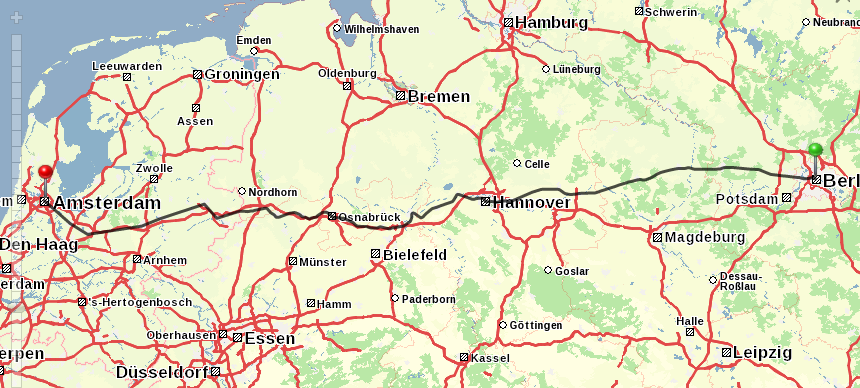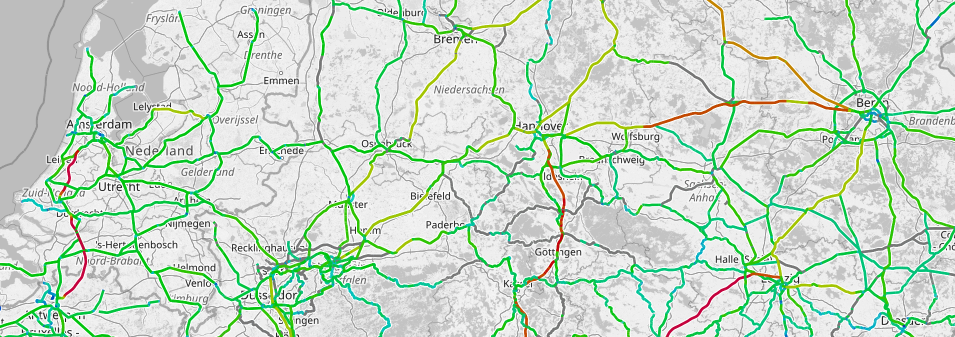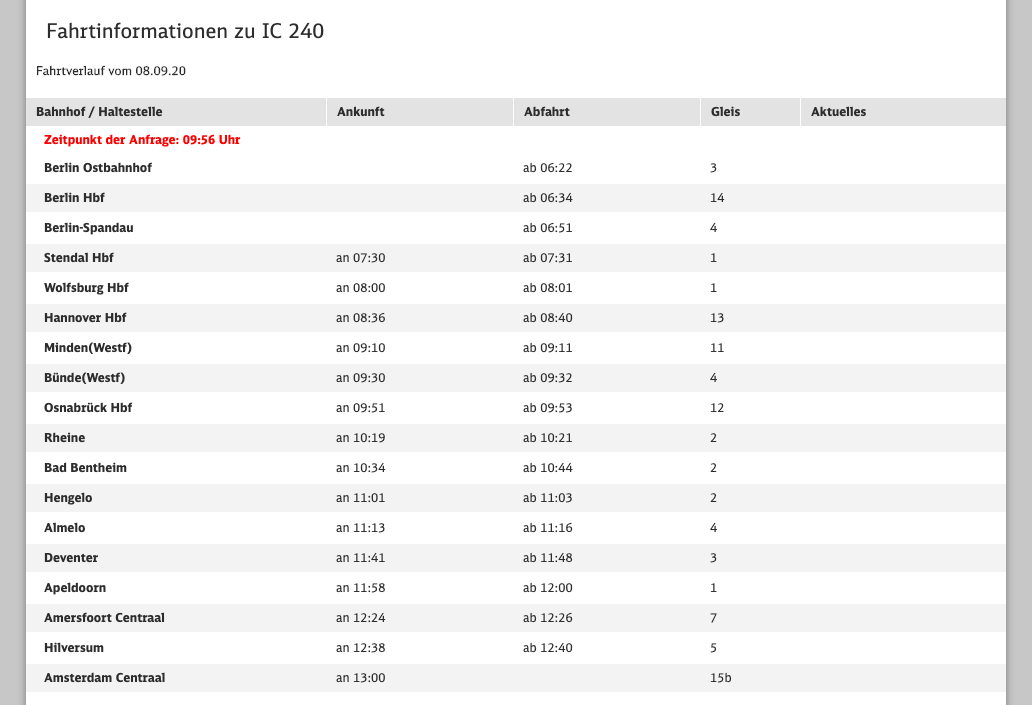This tweet and news story from The Netherlands caught my eye this morning – “Dutch Railways will make trains to Berlin and Brussels much faster: “We want to seduce air passengers”” the title says.
Whether prioritising that route – to get people off planes – even makes sense is open to question. It doesn’t feature in the top ten routes for that I analyse here.
The article then goes on to say that Amsterdam to Berlin trips will be reduced by 30 minutes, from 2024.
But the current journey time is 6 hours 26 minutes Amsterdam Centraal to Berlin Hauptbahnhof… I am not sure a reduction to 5 hours 56 minutes is going to help much.
Seriously though, if you wanted to do something about this route, and to speed it up, what could you do? The example here could no doubt likewise apply to other cross border routes as well – that’s why this post will be so detailed.
First, what could you conceivably change to speed up a rail connection? These are the questions to ask
- Is the maximum speed of the train lower than the maximum speed of the track, or vice versa?
- Is there any alternative route that could be taken?
- Would it be possible to eliminate stops on the route?
- Are there any other operational time savings to be made?
- Are there any non-speed factors that would also help?
- Are there any really radical solutions?
I’ll answer each of them in turn.
1. Is the maximum speed of the train lower than the maximum speed of the track, or vice versa?
This is the route the Amsterdam – Berlin train takes – black line:

And this is the relevant part of Open Railway Map – mid-green in Netherlands is 130km/h, yellow-green around Hannover is 200km/h, dark orange east of Wolfsburg is 250km/h:

The maximum speed of the train itself is determined in this case by three factors – the locomotive used in Netherlands, the locomotive used in Germany, and the maximum speed of the carriages used for the trip. The locomotive in the Netherlands is either a NS class 1600/1700/1800 or a Traxx – both with a maximum speed of 160km/h. In Germany it’s a DB Class 101 – maximum speed 220km/h. And the carriages are all rated at 200km/h.
So – in short – the track is the limiting factor between Amsterdam and the German border, the track is the limiting factor between the German border and Wolfsburg, and the carriages and locomotive are the limiting factor between Wolfsburg and Berlin.
What are the plans to speed up either of these?
Germany is planning a new, 300km/h line between Hannover and Bielefeld – that will reduce journey times between those two cities by 18 minutes (more here). The Amsterdam – Berlin train would take half of that route, so let’s generously list 9 minutes to be saved with that, by 2030.
Plans to increase the line speed from 250km/h to 300km/h, and from 200km/h to 250km/h through the nature reserve area between Wolfsburg and Berlin will save 11 minutes, by 2034.
Deutsche Bahn has order a fleet of 230km/h trains from Talgo to deploy on Amsterdam – Berlin from 2024. However those will only – in terms of speed – save any time between Wolfsburg and Berlin – about 150km of track. That saves 6 minutes, by 2024.
I am not aware of any other plans for infrastructure improvements anywhere else along the route currently.
Is there any alternative route that could be taken?
I cannot think of any long distance route that is as close to as-the-crow-flies straight as this is! Look at the map above. The only route change would be a small one in Berlin – the Amsterdam-Berlin train uses the old “Stadtbahn” through Zoo station to reach Berlin Hauptbahnhof. This has a Spandau-Hauptbahnhof journey time of 16 minutes. Running around the ring via Jungfernheide and into the lower level of Berlin Hauptbahnhof takes 10 minutes. This could save 6 minutes, immediately.
Would it be possible to eliminate stops on the route?
This is the really interesting one. This are the stops on the direct services each day:

Which of these could you eliminate?
Spandau cannot be eliminated – all Deutsche Bahn long distance trains stop there.
Stendal (popn. 39000) – this is even on a spur off the high speed line, so would be a good time saving. But other than very early morning and late evening ICE trains that stop there, the Amsterdam IC trains are the only direct Berlin – Stendal trains there are throughout the day. Were this stop to be eliminated, Deutsche Bahn would have to put on an alternative service to serve the town.
Wolfsburg (popn. 124000) – better served than Stendal, as some ICEs stop here throughout the day, but due to the Volkswagen plant there are considerable numbers of commuters to/from Berlin. As with Stendal, DB would need to provide some sort of alternative – a Berlin-Hannover stopping IC train in the hours the Amsterdam train does not run perhaps?
Time saved by eliminating Stendal and Wolfsburg stops: 12 minutes.
Hannover (popn. 500000) – cannot be eliminated as it is a major city and major hub station
Minden (popn. 81000) – Amsterdam IC train is its only direct connection to Berlin, but it is reasonably well served by other ICE and InterCity trains to Hannover, and RE trains to Bünde. Line speed is low through Minden anyway, so time saving is limited.
Time saved by eliminating Minden stop: 4 minutes.
Bünde (popn. 45000) – similar to the situation in Stendal, and a harder problem to solve than Minden as other connections to Hannover are poor. I don’t think you can easily eliminate this one.
Osnabrück (popn. 165000) – trains from Bremen / Hamburg towards the south cross the Berlin – Amsterdam line here. Important station for changing passengers. Cannot be eliminated.
Rheine (popn. 76000) – similar to Bünde. Very badly connected by long distance trains were the Amsterdam service eliminated. Keep it.
Ban Bentheim (popn. 15000) – border station. See “Operational Time Savings” below.
Hengelo (popn. 80000) – first stop in The Netherlands. Important for regional services. Keep it.
Almelo (popn. 72000) – served by other trains to Hengelo or Deventer. Eliminate.
Deventer (popn. 99000) – important for north-south connections. Keep.
Apeldoorn (popn. 162000) – well served by other trains, not important for connections. Eliminate.
Amersfoort (popn. 156000) – important station to change trains for Groningen, Utrecht, Rotterdam, Schiphol and Den Haag. Cannot be eliminated.
Hilversum (popn. 90000) – served by trains to Amersfoort or Amsterdam. Eliminate.
Time saved by eliminating Almelo, Apeldoorn and Hilversum stops: 12 minutes.
Of course the new boss of NL in her interview… only mentions the elimination of stops on the German side. Surprising, that.
Are there any other operational time savings to be made?
The new Talgo trains to be in operation by 2024 can run on both the 1.5kV electrification in The Netherlands and the 15kV electrification in Germany, eliminating the time spent changing the locomotive at Bad Bentheim. I presume crew would still need to change though. So the current 10 minute stopping time could be reduced to 3 minutes – saving 7 minutes.
Are there any non-speed factors that would also help?
The carriages used for the Amsterdam – Berlin IC train are now rather old. They might have some retro appeal, but they feel outdated, and the age of the carriages also dents reliability. There are power sockets for laptops, but no on-board wifi currently. A newer, more comfortable train with reliable wifi might help rail gain a bit of market share, especially for portions of the route.
Are there any really radical solutions?
Deutsche Bahn runs so-called ICE Sprinter trains on routes such as Berlin-München and Berlin-Frankfurt(Main) – trains with very few stops that run at peak hours only. The problem with these services is that they are hard to timetable as they do not easily fit into the regular hourly timetable. A very radical IC-Sprinter for Amsterdam-Berlin would stop only in Amersfoort, Osnabrück and Hannover – that could save an additional 20 minutes.
Beyond that the only other option would be to increase the line speed, or even build new high speed lines – and examine that for all of the route between Amsterdam and Minden. The short distance between the towns on the Dutch side means squeezing anything more than 200km/h there would be impossible without a whole new line. Upgrading Bad Bentheim-Osnabrück, and especially Osnabrück-Minden to 200km/h or even 230km/h would be operationally possible, although would lead to howls of protest due to the additional noise from inhabitants of villages near the track – but that would be the most economic way to reduce the journey time even further here. Only upgrading additional lines to 200km/h in The Netherlands, and to 230km/h on the German side, could possibly save a further 30 minutes.
Conclusions
Making major time savings on this route is very hard.
What can be foreseen for 2024 is a reduction of 12 minutes (eliminate Stendal and Wolfsburg), 4 minutes (eliminate Minden), 12 minutes (eliminate Almelo, Deventer, Hilversum), 7 minutes (no locomotive change at Bad Bentheim), 6 minutes (run to Berlin Hauptbahnhof via Jungfernheide instead of Zoo) and 6 minutes (230km/h Talgo trains) – a 47 minute reduction. Slightly better than the 30 minutes NS has talked of, but not without its problems due to the stations eliminated. Total Amsterdam Centraal – Berlin trip time: 5 hours 39 minutes.
Additional speed increase on Wolfsburg-Berlin, and new line Hannover-Bielfeld, by 2034, reduces the trip time by a further 20 minutes, so: 5 hours 19 minutes.
Radical solutions such as IC-Sprinter services, and maximum speed upgrades for tracks in The Netherlands and Bad Bentheim-Minden could save a further 50 minutes, so: 4 hours 29 minutes.
Oh, and one more thing…
Those Talgo trains that Deutsche Bahn has ordered for this route… they’re using an as yet untried locomotive, and even Talgo’s high speed power cars have not been tested or approved to run in Germany or Netherlands. And Talgo’s articulated carriage design is unusual, and had only previously been approved to run at 140km/h in Germany [UPDATE – as has been pointed out to me in the comments – this is incorrect. RZD’s Talgo night trains are approved to run at 200km/h in Germany. Only DB’s old Talgo night trains were cleared for 140km/h]. And Germany has had all sorts of nightmares approving unusual locomotives, like the Škoda build class 102. So getting all this into operation by the December 2024 timetable change… looks to me to be a push. I’d be happy to be proven wrong.
So overall: good luck with all of that NS and DB!
Updates
Useful extra data about the stops on the German side here – thanks Michael!
https://twitter.com/trassenfinder/status/1298959305484513281
An earlier version of the post stated the speed on the Dutch section was 160km/h – according to Open Railway Map. Dutch rail nerds tell me it is instead 130km/h. Because the map uses the same colour for that entire speed bracket. The post has been corrected accordingly.
This thread is also useful:
Great article, absolutely agree with the general conclusion.
Ops stuff:
I think the "Sprinter" is the only viable solution for a good long-distance connection, and you'd need to keep the current IC for the smaller stops. Compare Hannover-Köln below. 1/x pic.twitter.com/DwEfSyhYzL— Lenny du Nord (@Lenny_du_Nord) August 27, 2020
The consensus among rail nerds is it would be better to keep Deventer and drop Apeldoorn. The post has been updated accordingly – but it makes no difference to the time saved.

Great article! But there have also been plans to redirect the ICE via Utrecht, Arnhem and Duisburg. This might also decrease traveling time. More (in Dutch) here https://www.treinreiziger.nl/ns-175-miljard-nodig-voor-ice-naar-berlijn/
Ooof. It might work better on the Dutch side, but that’d be a really bad idea on the German side – it’d put it right into the already crowded Ruhrgebiet! I’m not sure you would save time overall, and you would definitely lose on reliability.
Given how slow the train is, and how flat the terrain, cycling looks the most attractive option to me
Interesting post!
There have been talks about rerouting the Dutch part as follows: Amsterdam – Almere – Zwolle – Almelo. The alignment between Almere and Zwolle is suitable for 200 km/h. It has considerable consequences for the connections towards Utrecht en Rotterdam though.
There’s a whole history of plans and discussions in Dutch on Treinreiziger (Train Traveler): if you want to have a crack at Dutch, check “reistijd Berlijn” on https://www.treinreiziger.nl/zoeken/ 🙂
For instance: taking the high-speed lines via Arnhem and Duisberg could bring it down to 4 hours “by the end of 2025”: https://www.treinreiziger.nl/snelle-trein-naar-berlijn-mogelijk-arnhem-en-duisburg/
People on the Dutch side keep suggesting the Duisburg route. But through the Ruhrgebiet it’s so damned overloaded already DB would not want any more trains there… I think improving the current route, or perhaps going via Zwolle, are the only solutions here.
To bring business people on this line, the only solution is, that a train with very new material and high quality service has to be brought on this line. This might for example with very minimum stop leave Amsterdam at 7 in the morning an arrives in Berlin at 12. Business persons then make meetings in the afternoon and will use this train, which leaves Berlin at 6 in the evening and will arrive in Amsterdam at 11 in the evening.
Deutsche Bahn will never make such an offer, but I made a proposal on this following a high level meeting, which we had during the last INNOTRANS with the boss of NS on side and the german secretary of State, Mr. Ferlemann, on the other side. NS has to make this investment and should make this offer to the public.
Peter Cornelius
Head of regional organization for Berlin-Brandenburg of passenger organization PRO BAHN
Indeed – because each side will blame the other for not making improvements. The usual story in cross border rail in the EU :-/
Today a follow-up was published with some notes from the passenger’s point of view:
https://www.ad.nl/binnenland/ns-niet-op-blauwe-ogen-geloven-voor-internationale-reizen-kijk-ook-naar-concurrenten~ac29db91/
At the moment there are plans to speed up some trains by 10 minutes in the Netherlands in the 2021 timetable because more capacity is needed for commuters in rush hour (!). This would bring a faster path without a stop in Apeldoorn, and additional national trains will run in the current path instead (Amsterdam-Amersfoort, and extending The Hague-Amersfoort services to Deventer.)
Sadly this involves breaking some connections between local trains in Weesp on the busy Amsterdam-Amersfoort railway.
Skipping stations on the Dutch side seems a hard thing to do for the next CEO. First the international train to Berlin was additional on the timetable between Amsterdam and the east of the Netherlands. However when the frequency of the Berlin – Amsterdam (v.v.) train went up a couple of years ago to 6/7 times a day, this train replaced the ordinary Intercity between Enschede – Amsterdam.
Only for the last bit (Hengelo – Enschede, 10 km. or so) there was an extra connection, so the original frequency (twice an hour) between Enschede – Amsterdam could be maintained. Eliminating stations like Almelo and Apeldoorn would mean that NS would have to run 7 additional, ordinary intercities on the same strech. Which is at peak capacity already, and is also increasingly looked at by freight trains between the Netherlands and Germany.
Building a complete high speed line in the Netherlands seems very complex too. Though I would certainly give it my blessing. The current line runs through one of the largest conservational areas in the Netherlands, past old inner-cities, passing a major river and some canals. In addition there is still a fierce discussion going on in the Netherlands to deviate the connection to Berlin from the Amersfoort – Hengelo/Enschede corridor to Utrecht – Arnheim (which is the preferred route for the NS who wants to concentrate its investment and also eyeing to improve connections from Amsterdam to Koln/Frankfurt). This would add approx. 80 km. to the connection and (possibly) a transfer in Duisburg and would do little to the current travel time, but can ultimately run at higher speeds.
NS might want to run via Duisburg, but DB almost certainly will NOT want to do that – as the Duisburg-Essen-Dortmund line is already really over capacity. It might work out to run faster, but reliability would definitely suffer!
Quote:
“And Talgo’s articulated carriage design is unusual, and had only previously been approved to run at 140km/h in Germany. ”
That is wrong, the Russian Railway is also running Talgo Trains to Berlin, they are approved for 200 km/h. However, I agree to the problematic new locomotive design …